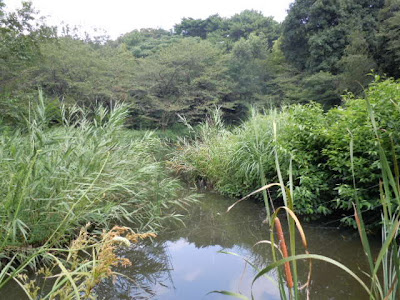A few weeks ago we zipped up to South Tokyo to check out the Institute of Nature Study, a branch of the National Museum of Nature and Science. This 200,000 square meter natural habitat has been left undisturbed for over sixty years so it offers a glimpse of what Tokyo might look like if people didn't live there.
Ishii-san snagged me a brochure printed in English which I'll pass along to my home-schooling pals to help them plan a field trip. (I have a surprising number of home-schooling friends and acquaintances these days because they tend to be knitters, at least in this part of the world. They also tend to be quite brainy, droll, and witty which is one of the main reasons I skip happily off to the coffee shop with yarn in hand on Monday and Thursday evenings.)
The nature stuff in the brochure didn't interest me all that much but the history section is worth repeating to jog my memory when my kids put me in a nursing home and present me with this blog in book form (hint, hint).
Nearly 600 years ago this piece of land belonged to the district lord, Shirokane Choja, who built a house and surrounded it with earthworks that can still be seen today. Lord Matsudaira took over the property during the Edo Period, after 1664, and created a garden with ponds. Two hundred years later, during the Meiji Era, the navy and army built warehouses here to store gunpowder but the land reverted to residential use in 1917 when it became an Imperial estate called Shirokane goryochi. The natural environment has been conserved since then and the area was designated as a national monument and historic site in 1949.
We checked out the exhibits in the Visitor Hall before exploring the grounds. Half of the exhibit area was devoted to dragonflies which I find about as frightening as butterflies, ie, very. All that erratic flitting is what I find disturbing. Dragonflies are quite benign when they are pinned down in glass cases or captured in magnified photographs.
 |
| I would not care to meet the big one on the right in the wild. |
 |
| Who knew they climb out of hard cases like cicadas? Not me. |
 |
| A natural habitat in Tokyo after more than 60 years |
The Tokyo Metropolitan Teien Art Museum, housed in the Art Deco mansion built by Prince Asaka in 1933, is right next door to the Institute for Nature Study. We decided to check out that garden while we were in the area and have lunch in the museum cafe. Stay tuned.

No comments:
Post a Comment